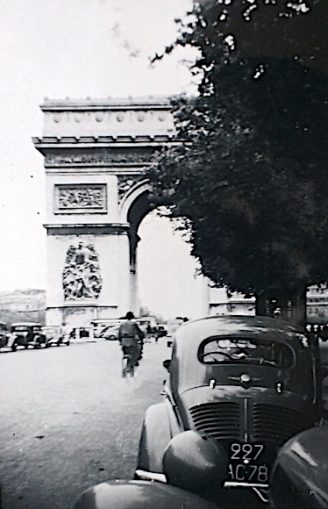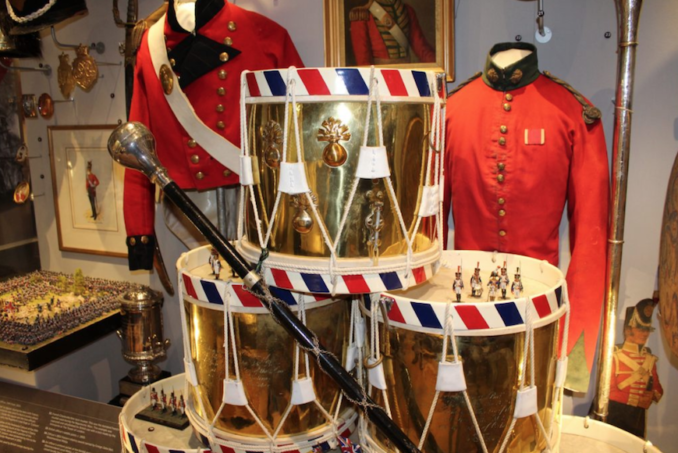As we reach the end of our 1952 Nostalgia Album adventure to Gibraltar and back, my father and his parents remain at the top of the Eiffel Tower gazing at the more distant of the Seine bridges.

© Always Worth Saying 2022, Going Postal
At point A there now stands the Radio France building. Similar to BBC’s Television Centre in West London’s Shepherd’s Bush, it is a circular construction of offices surrounding studios. A monstrosity on a par with the Speer flack tower that is the Australian Embassy on the opposite bank of the river, a Street View link is forbidden as both the EU and Ukrainian flags fly on the pavement outside.
A disappointingly redeveloped part of the city, one or two worthwhile buildings have survived along Rue Gros to the south of the Radio France subdivision. Puffins will be familiar with Charles Blanche’s unfussy 1901 Art Nuveau No.9 and the Modern 1927 apartment block at No.37, but it is the upper stories of the recently restored No.17 which catch the eye. In a district famous for its artists, (the avenue is named after Antoine-Jean Gros, of Napoleon Visiting the Plague Victims of Jaffa fame) one immediately thought of the high upstairs windows as belonging to artist’s studios, such as our at own St Paul’s Court on Talgarth Road, also in West London.
However, in the buff that accompanied the property’s recent redevelopment, the top floor of the four-story redevelopment is described as workshops and, with the lower floor remaining as a car showroom, the layout shows itself to be more artisan than artist. Rebuilt as social housing and with a restored facade, No.17 shows what can be done (albeit at vast expense) to preserve an area while maintaining its usefulness.

© Google Street View 2022, Google
The even-numbered side of Rue Gros tells a different story. Designated as a ZAC, a ‘concerted development zone’ or ‘building zone’, planning regulations have been avoided where projects deemed as a priority can be fast-tracked. Perhaps unsurprisingly, the resultant architecture looks rushed, unnecessary and out of place. Hotel Square is not unpleasant, but should be somewhere else, perhaps the stag night district of Baltic port? Next door sits a provincial East German fire station and next to that the École Polyvalente Publique Gros which is just plain ugly and spoils the view from the exquisite upper floors of No.17 opposite.
Bridge B is the Pont Mirabeau, a low-slung metal structure not done justice by its distance from the camera. Not a box girder construction but a metal latticework with a central span which arcs an impressive 101 yards across the river, two piles sit at either side of the central span representing two boats with a statue at each end, as if on the prow and stern, representing the City of Paris, Navigation, Abundance and Commerce.
The coat of arms of the city of Paris sits in the middle of the main span and is represented as a trading boat above the motto, ‘Fluctuat Nec Mergitur’, meaning ‘bouncing on the waves but does not sink’. It might seem odd that a city well over 100 miles from the sea has a trading ship as its arms but the Seine is navigable to this point and even in the modern day there is a builder’s wharf just the other side of Pont Mirabeau where barges unload materials to a concrete factory and a long line of awaiting cement mixers.
Although Pont Mirabeau pre-dates 1952 the same is not true of the next bridge which is point C and is currently called Pont de Garigliano. Rebuilt in 1963 in its present form as a three-span metal bridge soldered to six beams and carried on two piles, between 1863 and 1962 the crossing was a two-level stone structure with a railway line on the upper story. Then known as the Viaduc d’Auteuil or the Viaduc du Pont-du-Jour, it was a magnificent structure but with increased road traffic and with the stone arches of the lower level being too low for navigation, it had to be replaced.
The present bridge is now the highest across the Seine, a full 33 ft above the water. As such it has become, as the French put it, ‘popular’ with suicides. Again, distance does not do the structure justice. In the 1952 photo, the upper lever can barely be seen but is more prominent in the early 20th-century photograph shown below.

Panorama de Paris : Vue sur la Seine prise en aval de la Tour Eiffel,
Neurdein – Public domain
Taken from the same spot as the 1952 photograph, as well as seeing more of the Pont d’Auteuil we can also see goods yard at the base of the Eiffel Tower coming from a spur of what we discovered last week to be RER line C. In the modern day, the rails are concealed by a cut-and-cover type construction topped by the Quai Branley road.
A close-up of the d’Auteuil shows the upper level in all its glory with the pictured train traversing the Petite Ceinture line, a circular rail route built to supply the city’s 1845 fortification walls and to transport passengers and goods between the city’s major rail termini.

La Seine à travers Paris : le Viaduc d’Auteuil,
Scanné par Claude Villetaneuse – Public domain
This reminds us to an important truism: railways on the continent were built to move soldiers about and railways in England were built to move coal about, hence the more generous loading gauges on the other side of the channel. Puffins will have noticed the bigger seats and more spacious luggage racks when climbing aboard at Calais Maritime with their kettles, stoves and freshly purchased cartons of Gauloises.
Bits of the Petite Ceinture are still there, with some track remaining in place, and can be followed on the satellite mapping east of d’Auteuil / Pont de Garigliano. It runs north of tram line T3 on an embankment and bridges and is just above the blurred-out military area at Boulevard General Martial Valin. At Place Balard it becomes a public walk and cycleway to Parc Georges Brassens. By this point we are back on ground level and the track work is visible. It proceeds under the approaches to Gare Montparnasse but then seems to cease to exist upon reaching a housing project. It reappears in a trench as a single line running parallel between Rue Giordano Bruno and Via Brune. Intact, with worn wooden sleepers and thin ballast sunk into the ground, the rails don’t appear at all rusty and are pinned directly to the ground with overlapping bolts rather than being clipped.
The disappears underground at the Virginia Hotel and one suspects the Rue Paul Fort is built on top of it. (Hope I’m not boring you). Extra house points for any Puffin who can find the next stretch, presumably heading for Gare Austerlitz.
Readers will have become familiar with the idea that the French name their bridges ad boulevards after skirmishes rather than empire-building victories. Skirmishes often lost or that more honestly should be credited to allies. In the modern day, the new bridge is named after a disgraceful episode in French military history fought around the river Garigliano during the Italy campaign of 1944. A public square, just to the north of the Arc De Triumph, carries the name of the senior officer responsible; Alphonse Juin.
Although an American and British effort, the Battle of Monte Casino (named for the monastery guarding the strategically vital route from Naples to Rome), included French units albeit Moroccan irregulars, the Gourniers, expert with the curved Moorish dagger of the same name and adept at mountain warfare. Under the control of General Alphonse Juin, the Gourniers crossed the Garigliano river close to Monte Casino and engaged the Germans in near impenetrable hills around about their defensive Gustav Line. Although a well-respected soldier who rose from private in 1909 to Marshal of France by 1952, Juin lost control of his men who were responsible for a series of atrocities committed against civilians which to this day the Italians know as the Marcocchinate or Moroccan deeds. According to wiki,
[The Gourniers] mostly targeted civilian women and girls (as well as a few men and boys) in the rural areas of Southern Lazio, between Naples and Rome. Mass rapes continued across all the campaign including several locations in Tuscany: Siena, ad Abbadia S. Salvatore, Radicofani, Murlo, Strove, Poggibonsi, Elsa, S. Quirico d’Orcia, Colle Val d’Elsa.
In the aftermath, 207 soldiers were tried for sexual violence. Others were executed without trial. Soon after the war, France paid compensation to 1,488 victims.
A more understandable memorial is the Arc de Triumph, which commemorates those who fought and died for France in the French Revolutionary and Napoleonic Wars. The names of all French victories during the period (including the aforementioned Battle of Jaffa), and the generals responsible, are inscribed on the Arc’s inner and outer surfaces. Beneath, a vault contains the Tomb of the Unknown Soldier from World War I.

© Always Worth Saying 2022, Going Postal
Standing at the confluence of twelve radiating avenues, including the Champs Elyse, the neo-classical arch is 164ft high and was designed by Jean-François-Thérèse Chalgrin and Louis-Étienne François Héricart-Ferrand, Vicomte de Thury. Photographed in simpler times, there wasn’t a lot of traffic, it could be traversed by bicycle and you could park next to it.
Not included on the list of victories is the Battle of Arroyo dos Molinos during the Peninsula War of 1811. Not only did Johnny Napoleon (uncle of old friend of Nostalgia Album, Napolean III) get a bit of a black eye but one of our local Debatable Lands regiments of foot helped themselves to his drums during some light pilfering. French Puffins concerned about ‘their’ drums will be pleased to hear they’re nice and safe in our regimental museum at Carlisle Castle, well worth a visit.

Side-drums of the 34e Régiment d’Infanterie,
Cumbria’s Museum of Military Life – Licence CC BY-SA 4.0
As our Nostalgia Album trip draws to an end, we see my grandparents on the roadside somewhere in continental Europe. An English travelling gentleman and his lady wife must take tea at precisely 12 noon. If that involves leaving the roadway and bouncing a Ford 8 over a ditch, so be it. Suits and best dresses are advised, a tie is optional. Pictured, we can see the old kettle, previously captured in an earlier episode beside a public well at Boceguillas in Franco’s Spain. As for the stove, it is collapsable and fits into the tube to the right. There is a lid. How do I know this and why do I use the present tense? The Worth-Sayings are not good throwers-awayers and I still have it. It is used periodically to boil bicycle chains and recently disgraced itself by refusing to light (it is nearly 100 years old) on a Duke of Edinburgh Award expedition. The boys ate raw food off the ground instead (as boys do).

© Always Worth Saying 2022, Going Postal
My grandfather seems to have something in his mouth. Clothes pegs? Half a dozen Gauloises? Whatever. Before the hysteria of so-called global warming, an Englishman could smoke six cigarettes at once while boiling his kettle over a naked flame among the tinder-dry straw of a parched foreign field without causing alarm. If the place catches fire, stamp it out with your hands and feet. Better times.
After turning the final page of our Nostalgia Album, we end up back where we started in Carlisle. On hand are the band of the King’s Own Royal Border Regiment who insist upon playing us out with D’ye ken John Peel, appropriately accompanied by old friend of Nostalgia Album Napoleon III’s uncle’s drums.
Is this really the final page? Or just the end of the boring bit? Find out next time on Nostagial Album!
© Always Worth Saying 2022


